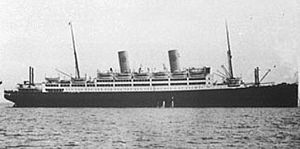MS Kungsholm (1928)

MS Kungsholm around 1930.
|
|
| History | |
|---|---|
| Name: |
|
| Owner: |
|
| Builder: | Blohm + Voss, Hamburg |
| Launched: | 1928 |
| Maiden voyage: | 1928 |
| Identification: | IMO number: 5516547 |
| Fate: | Scrapped, 1965 |
| General characteristics | |
| Type: | Passenger liner |
| Tonnage: | |
| Length: | 181.32 m (594 ft 11 in) |
| Beam: | 22.0 m (72 ft 2 in) |
| Draught: | 11.52 m (37 ft 10 in) |
| Propulsion: | 2 × 8-cylinder Burmeister & Wain diesel engines, 2 shafts |
| Speed: | 17.5 knots (32.4 km/h; 20.1 mph) |
| Capacity: |
|
MS Kungsholm was a passenger liner owned and operated by the Swedish American Line from 1928 to 1941 on transatlantic services from Gothenburg to New York City as well as cruising out of New York. It was built at the Blohm & Voss shipyard in Hamburg, Germany.
Kungsholm operated on the trans Atlantic service with some cruise operations just prior to World War II.
In June 1938, as flagship of the Swedish American Line, she visited Wilmington, Delaware with the Crown Prince Gustaf VI Adolf and Crown Princess Louise of Sweden, members of the Royal Swedish Commission, the Commission of the Republic of Finland and tourists aboard. The visit was in honor of the 300th anniversary of the Swedish landing with the Crown Prince's son Prince Bertil having to do the honors ashore as the Crown Prince was suffering from a kidney attack.
For a brief time 1940-41, as Kungsholm was cruising the Caribbean after war broke out in Europe, the author J. D. Salinger was employed aboard as entertainment director.
The ship, under the command of Captain John Nordlander, was requisitioned effective 31 December 1941, placed under control of the United States Government's War Shipping Administration (WSA), renamed John Ericsson and delivered for contract operation by United States Lines as a troop transport largely to meet Army requirements.
John Ericsson was one of seven transports hurriedly assembled in New York and sailing late on 22 January 1942 (23 January GMT) in what was then the largest troop movement attempted, movement of POPPY FORCE, also designated Task Force 6814, under General Alexander Patch to secure New Caledonia (codename POPPY) on the vital South Pacific link to Australia. At the time this force was being assembled the ship was allocated to the State Department and with its addition and cutting troops in convoys across the Atlantic the seven ships assembled had a troop capacity of almost 22,000. Task Force 6814 was later organized in New Caledonia as the Americal Division.
...
Wikipedia
